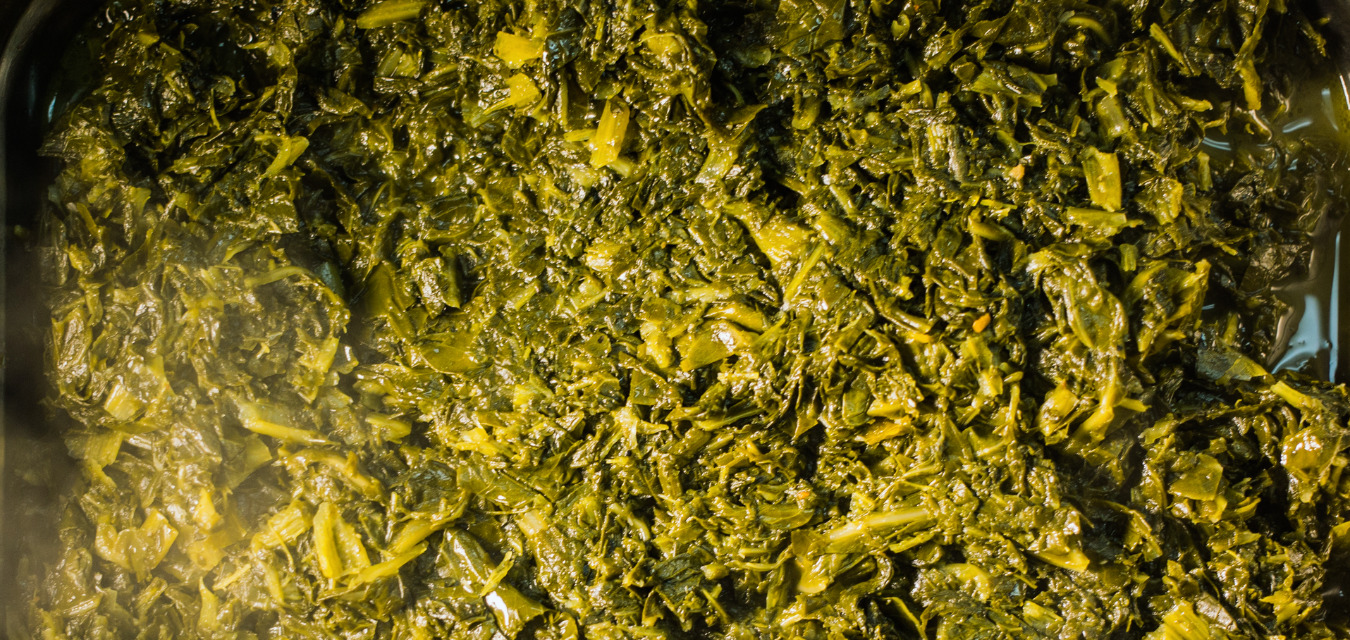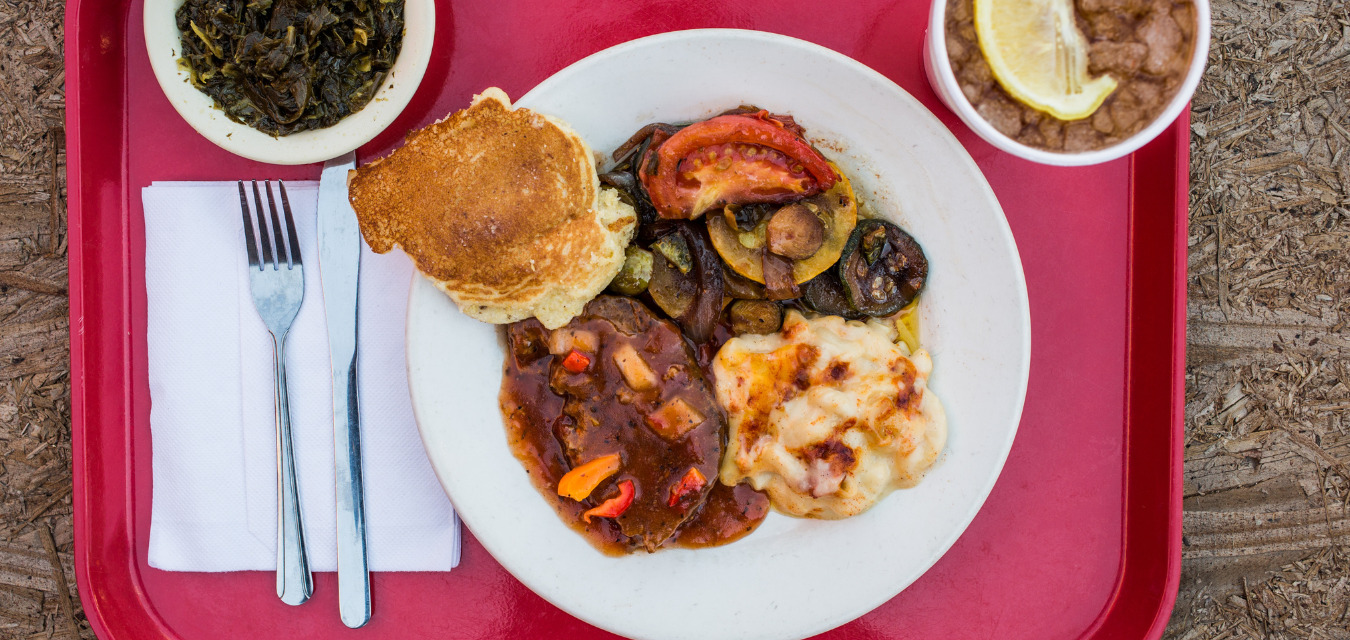After 40 years in business, Arnold’s Country Kitchen closes doors but leaves us full of food and memories. Editor in chief Erin Murray reflects on her inaugural visit to the Nashville haunt and the family behind it.
Like many transplants, when I moved to Nashville from Boston in 2012, I experienced my fair share of culture shock—the constant, genuine hospitality alone had me feeling like Alice stumbling into Wonderland. While I was excited by the prospect of getting to know my new city through its native foods, I was actually not expecting to find any big surprises on the edible landscape. Having lived in this part of the country during my childhood and continuing to visit often throughout my life, I thought I knew Southern food. But one surprise quickly emerged: I had no idea what to expect when someone told me I needed to check out a “meat and three.”
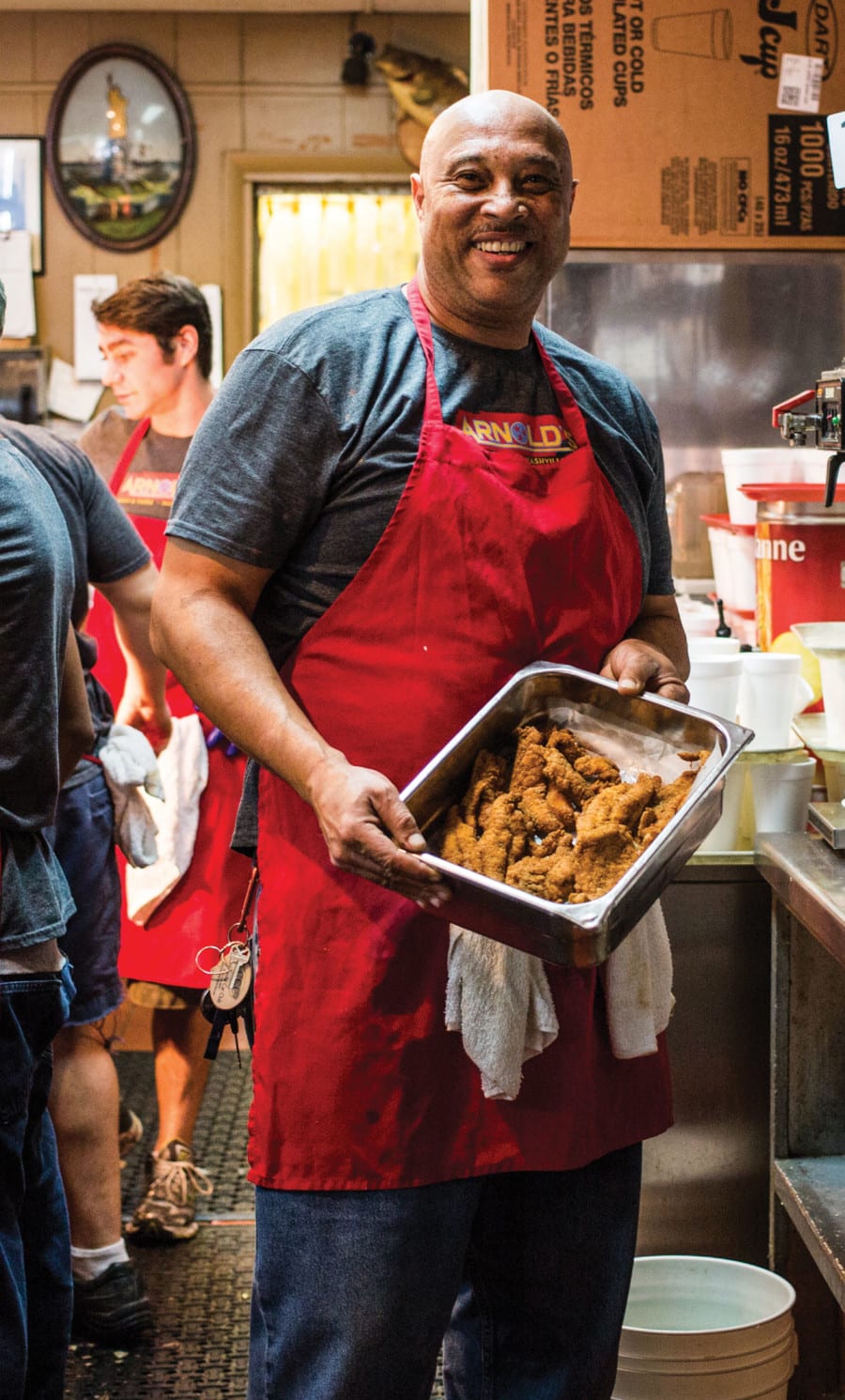
Locals mentioned these mysterious eateries regularly in Nashville, and Arnold’s Country Kitchen came up again and again as the standard-bearer. Unclear on what, precisely, a meat and three was, I enlisted a fellow food writer to join me on my inaugural trip to the lauded Arnold’s.
If moving South took me down the rabbit hole, my first visit to Arnold’s Country Kitchen was like taking a seat at the Mad Hatter’s tea party. The cafeteria-style, steam table restaurant is a special local institution, thirty-four years running, and located in a part of town that has seen (and continues to see) rampant change. Construction cranes crowd the surrounding skyline, and the city’s massive new convention center opened a few blocks away in 2013, enlivening a section of town that also serves most of the city’s homeless population through a handful of shelters. Sitting at this unique intersection of old and new, Arnold’s is open Monday through Friday for lunch only, serving up trays of satisfying Southern fare for just a few dollars a plate, with recipes that have changed only slightly since Jack Arnold made this space his own in 1982.
Arriving for that first visit, the line bulged out the door—and it was only 11 am. As we patiently shuffled closer to the stack of red trays set next to the steam table, folks dug into their dishes at the communal tables around us, filling the air with an endless stream of chatter, filling their bellies with the piles of delicious-smelling food, and filling Arnold’s with what can only be described as heart and soul. No televisions blared. Background music came in the form of steel cutlery hitting ceramic plates.
Once at the steam table, things moved fast. When the cooks asked me what I’d have, I felt overwhelmed by the sheer selection listed on the blackboard behind them. About to seek guidance from my friend, my answer instead came from behind the line. A smiling woman—perhaps used to needing to make the odd newcomer feel welcome, or perhaps just perennially warm—jumped in. “We got sugar-cured ham today, honey, and you don’t want to miss that. How about some beans, too? These butter beans are fresh and we’ve got tomato salad, too.”
With that, my plate was piled. After paying at the cash register, we slid our trays onto one of the crowded communal tables. As people automatically adjusted to make room, I felt the welcoming warmth of my new community. I felt a sudden understanding of what a meat and three is.
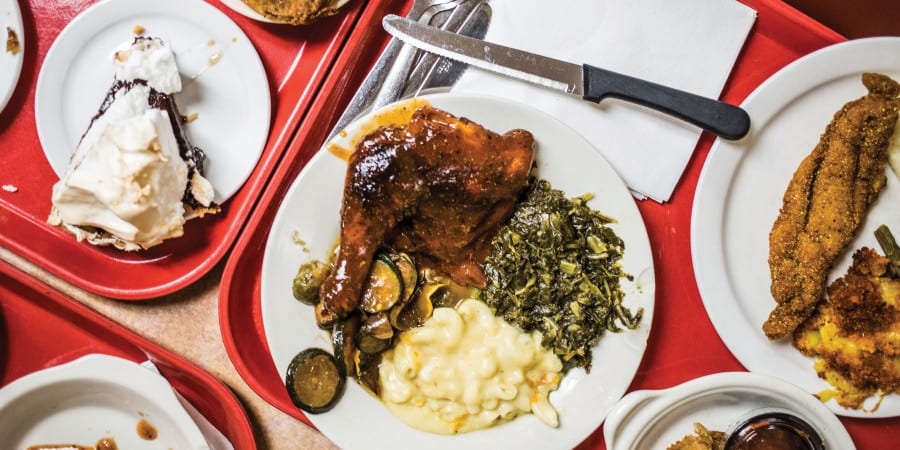
Defining the Meat and Three
To break down the mystery, a meat and three is comprised of three essential traits. First is the style of the restaurant—all meat and threes are cafeteria-style, down-home joints. There might be a line leading up to a steam table where you choose from a variety of daily offerings or a waitress waiting with a cup of sweet tea. It’s casual, inexpensive, and there are probably photos of regulars on the wall.
The second identifiable trait is the food— classic, unapologetically Southern fare, inspired by the farmhouse kitchens that predated the suburban landscape. Plentiful options are based on traditional Southern country cuisine—turnip greens cooked tender in a porky broth; sugar-sweet candied yams; crackling-crisp fried chicken; juicy slices of roast beef. A true meat and three makes this food from scratch, using fresh produce, meat, and dairy, and usually starts prep work a day or two in advance. And the name says it all—you’ll be getting one meat and three sides, in the form of vegetables, beans, or grains. Biscuits, cornbread, or a roll are often included, as is dessert, which might include seasonal cobbler, pudding, and naturally, pie.
The third trait true of the majority of these Southern mainstays is how they showcase a unique slice of a community’s people. Most meat and threes are family-owned and operated. You will likely encounter the son, daughter, or sometimes grandchild of the original owner on the line, at the register, or clearing plates.
There’s a certain sense of hospitality, joy, and, most of all, pride to be found. These were businesses built with no small amount of grit and elbow grease. Regulars are the bread and butter of the enterprise and it’s not unusual to enter a place like Arnold’s Country Kitchen, as I did, and feel like you’re walking into a large, informal family dining room. Meat and threes are places that feed the masses, that seemingly cater to the working man. But they are also egalitarian in that you’ll also find everyone from politicians to famous chefs, plus, these days, more than a fair share of curious visitors.
The Evolution of Arnold’s Country Kitchen
Though meat and threes exist all over the South, Nashville is an arguable epicenter, having long boasted more of this style of restaurant than most Southern locales. And Arnold’s reigns supreme among the many quality options. Indeed, ask anyone in Music City where to eat, and they’ll likely guide you toward Arnold’s.
Originally owned by Lynn Chandler, who also owned the city’s iconic Elliston Soda Shop, it was called Lynn’s Cafeteria when Jack Arnold first went to work there. Jack arrived in Nashville from Asheville, North Carolina to study pre-med or art (an answer that varies depending on who he’s talking to) at Vanderbilt University. He worked at several restaurants, but it was when he got to Lynn’s that he started to tweak recipes. His kitchen creativity quickly resulted in his taking over the breakfast shift. Soon, he gained a loyal stable of customers and when Lynn told Jack that he wanted to sell the place, Jack took an interest.
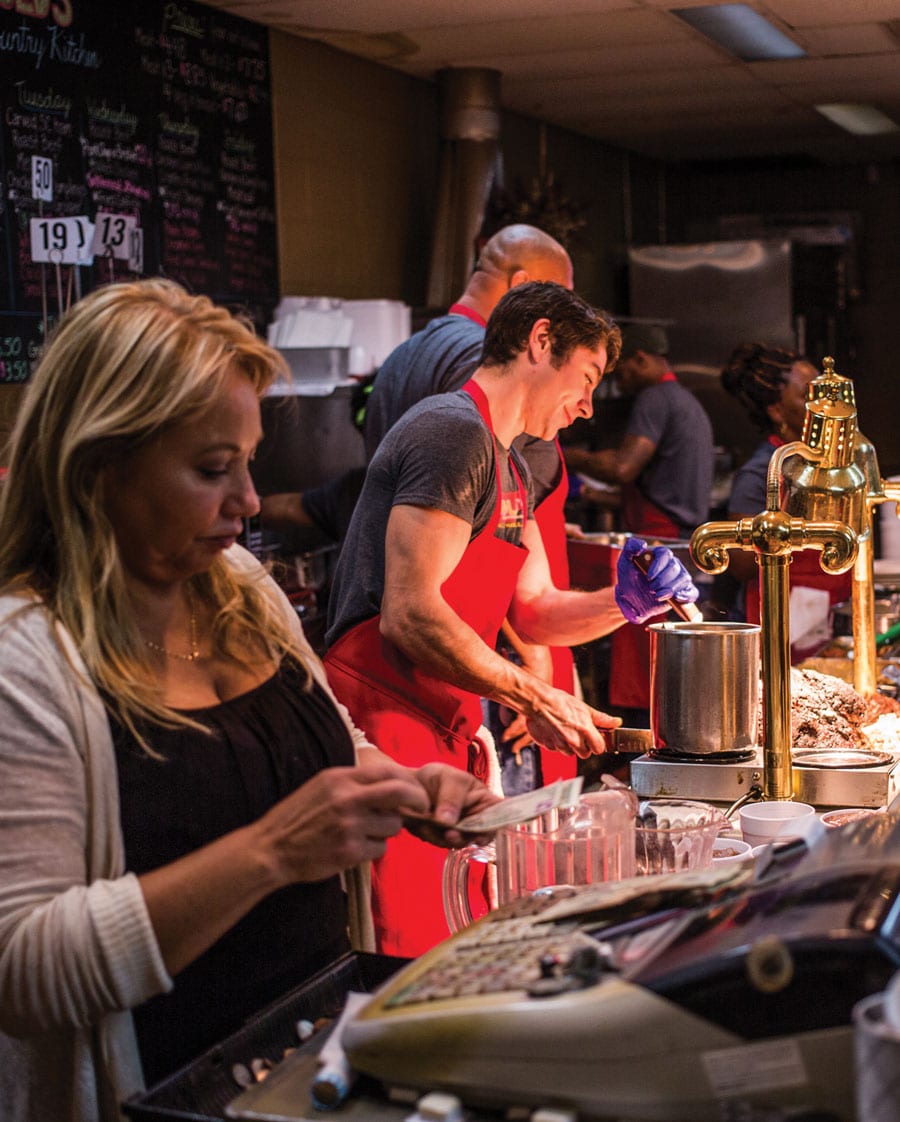
Kahlil Arnold, one of Jack’s sons and the current torch-bearer at Arnold’s, tells the story of Jack needing to raise $12,000 for the purchase, a sum he received in full from a regular diner, whom he paid back one year later. Over the years, Kahlil and his siblings have all worked in the restaurant, washing pots or helping in the dining room. When Kahlil went to college, his intention was to try something outside the family business. After exploring a few other professional tracks, he ended up working at the Loveless Cafe, which was then run by restaurateur Tom Morales.
In 2005, Jack called Kahlil and told him that he was thinking about selling Arnold’s. “I’m older now,” Kahlil recalls him saying, “And I can’t do this by myself. Maybe you can just help me get it up and going and we’ll sell it.” As the story goes, Tom was about to offer Kahlil the general manager position at the Loveless when Kahlil told him he had to go back to the family business. Tom, understanding of the situation and friend to the Arnold family, simply said, “How many of my staff members do you need me to send?”
The sale of Arnold’s never went through, of course, and Kahlil has now taken over the business completely—but not without butting heads with his father along the way. “The next few years were really difficult because he was still here every day, us running it together. That was hard,” Kahlil admits. “He knows more about food than I’ll ever know. He lived and died for this place for years. He still sometimes will come in and say, ‘you know, the reason it turned out like that is because you cooked it at the wrong temperature,’” he laughs. “And I just have to step back and admit he’s right. He just knows it.”
The menu and recipes at Arnold’s today are almost exactly as they were when Jack ran the place with a few minutes and judiciously made changes by Kahlil, like swapping panko for the standard breadcrumbs on their catfish.
“People, our customers, expect to come in and have their country steak on Thursday, or meatloaf on Tuesday. You have people like Porter Wagoner, who came here for years and years—he still came here after my dad retired—and he would be first in line. How are you going to say ‘Porter, we don’t have your meatloaf today?’ You just don’t do that.” Instead, Kahlil took baby steps, changing an ingredient here or there, and adding new items to the lineup. “We have to stay current, but it will never be extreme,” he says.
How Arnold’s Country Kitchen Balanced Tradition and Transition
Family tradition and the transition from one generation to the next is a common theme for today’s meat and three. Faced with a changing clientele and evolving diets and trends, those that have survived did so by evolving themselves, even if ever so slightly. Wendell Smith’s is another Nashville institution, which has occupied the same corner on Charlotte Avenue since about 1952. Smith opened it, as he was known to say, so he’d have some place to drink his coffee. The restaurant, now a meat and three diner, is overseen by Smith’s grandson Benji Cook, who took it over from his father Jakie Cook. In the kitchen, little to nothing has changed since Jakie Cook turned it into a soul food joint. Recipes have been passed down at the elbows of the cooks, such as Dolleen London, who has been running the kitchen for twenty-odd years with no written recipes to speak of.
And Benji, like Kahlil, returned home from exploring other pursuits (he worked on private yachts, running transatlantic trips) to help his father with the family business in 1992. Though he grew up washing dishes and working the cash register, taking the reins was another challenge entirely. “Dad still shows up every day and he’s still the boss—he lets everyone know it, too,” laughs Benji, now 50 years old. His own sons, both in high school, work at Wendell’s during the summer. Benji’s youngest has expressed an interest in carrying on the family tradition.
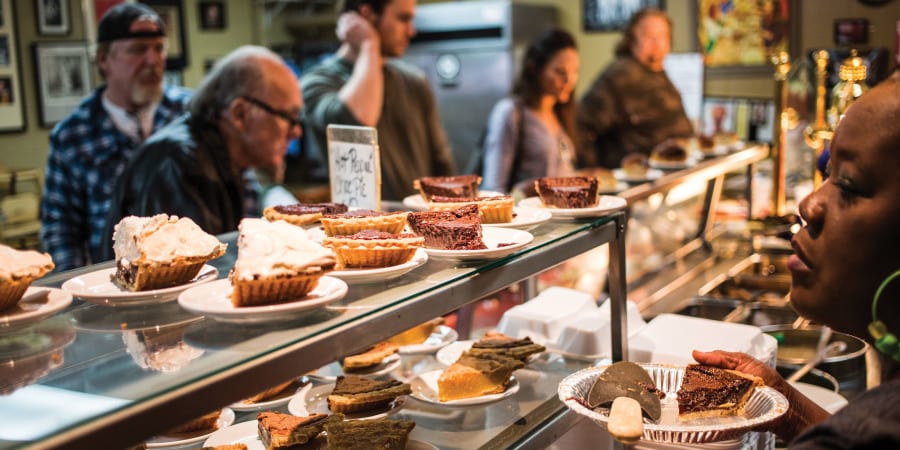
Most of the customers who frequent Wendell’s are old timers, he says, some of whom show up twice in a day. New people (“the hipsters” Benji calls them) seek out the restaurant regularly too. “They love it in here, and I think maybe it’s the nostalgia,” he says. “You can call it whatever you want. To me it’s all the same: soul food, meat and three, Southern. It’s cooking with bacon grease and a lot of country ham trimmings to season your beans. We’re cooking fifty bushels of turnip greens a week,” says Cook. “To me, it’s just home. People who still come here have watched me grow up, they’ve watched my kids grow up, and I’ve watched them grow, too. The best part of all of it is the people.”
For David Swett, owner of Swett’s, evolution has been his key to survival. His parents, Susie and Walter, opened the original restaurant in 1954 and ran it together, both working into their sixties. David came to work at the age of twenty-three. Through the years, the recipes at Swett’s have changed little, though David has added barbecue, which can be found in a different section of the restaurant.
“To me, it’s just home. People who still come here have watched me grow up, they’ve watched my kids grow up, and I’ve watched them grow, too. The best part of all of it is the people.”
Now 76, David still loves doing what he does because of the people. “To be able to sit down and have a conversation with someone in the middle of the day, that’s what I love.” He hopes to pass that along to someone in his own family. He has three sons, two of them chefs with their own meal delivery service. But it’s his daughter who lives in Mobile, Alabama, who has expressed an interest.
“I’ll still be here, though,” he chuckles. “Until the old man decides to take me…or my knees give out. Either way, I’ll be here until my last breath.”
Meanwhile, over at Arnold’s, change is in the air. Walls are going up all around the original building. Even the signature fire-engine red exterior wall has been hidden by new construction. This winter, the restaurant will close for a few months while the kitchen is outfitted with new equipment—which has been a long time coming. “I’m surprised that oven hasn’t exploded on me yet,” says Kahlil.
The addition will double the size of the dining room and likely hide the famous steam table line, which probably won’t stretch all the way to the new front door.
“We’re trying to accommodate our current customers, but we also want to make room for growth,” says Kahlil. Business is good for today’s meat and three, as both Benji and David will attest. For Kahlil, expansion is simply a way to offer more seats for those who appreciate the Arnold’s experience. “The food won’t change, except I would like to get even more local ingredients in here where I can. And we might even start offering beer,” he says. Evolution? Yes. Be it ever so slight. It’ll still be the same old Arnold’s, he insists. “As long as there are Arnolds in here and our customers keep coming, I don’t see anything being any different.”
Chef Khalil Arnold’s Meat and Three
Meatloaf with Tomato Creole Sauce
Originally published in the February 2016 issue.
share
in this article
-
New Restaurants in Arkansas
-
Shrimp and Grits: A History
by Erin Byers Murray -
Tea Cakes, A Brief History
by TLP Editors -
Gullah Geechee Home Cooking
by Erin Byers Murray -
A Cajun Christmas Menu
by TLP Editors






